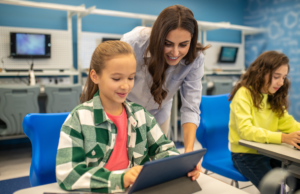Introduction
The educational landscape is changing dramatically in this age of rapid technological innovation and digital transformation. Traditional educational paradigms are changing as a result of the rise of digital learning environments, which present both new opportunities and difficulties for educators, students, and institutions.
The Future of Education: Navigating Towards Digital Learning Environments
Education has always been a dynamic field, constantly evolving to meet the needs of a changing society. With the rapid advancements in technology, the future of education is now being shaped by digital learning environments. These environments offer new opportunities for both educators and learners, revolutionizing the way knowledge is acquired and shared.
Enhanced Access to Education
One of the most significant advantages of digital learning environments is the enhanced access to education. With traditional brick-and-mortar schools, geographical limitations often restrict students from accessing quality education. However, digital learning environments break down these barriers, allowing learners from all corners of the world to access educational resources and connect with expert educators.
Furthermore, digital learning environments provide flexibility in terms of time and pace of learning. Students can access educational materials at their own convenience, allowing them to learn at their own pace. This personalized approach to learning ensures that each student can receive the support and attention they need to succeed.
Opportunities for Lifelong Learning:
The direction of education will increasingly focus on lifelong learning, in which people constantly pick up new skills and knowledge to help them cope with the fast changing world. For students of all ages and backgrounds, digital learning environments are essential for offering flexible and accessible learning possibilities. Lifelong learners can pursue their educational goals at their own speed using self-paced modules, online courses, or micro-credentials.
Interactive and Engaging Learning Experiences
Another key aspect of digital learning environments is the ability to provide interactive and engaging learning experiences. Traditional classroom settings often rely on passive learning methods, where students listen to lectures and take notes. However, digital learning environments leverage multimedia tools, such as videos, interactive quizzes, and simulations, to make learning more interactive and enjoyable.
Through these digital tools, students can actively participate in their learning process, which enhances their understanding and retention of knowledge. Additionally, digital learning environments can incorporate gamification elements, such as badges and leaderboards, to motivate students and make the learning experience more enjoyable.

Collaborative Learning and Global Connections
Digital learning environments also foster collaborative learning and global connections. Through online platforms, students can collaborate with their peers on projects, share ideas, and engage in discussions. This collaborative approach to learning promotes critical thinking, problem-solving skills, and teamwork.
Furthermore, digital learning environments enable students to connect with experts and professionals from around the world. Through virtual classrooms and video conferences, students can interact with industry leaders, scientists, and artists, gaining valuable insights and expanding their horizons. These global connections not only enrich the learning experience but also prepare students for a globalized world.
Collaborative Learning Communities
Across geographic borders, digital learning environments enable the development of collaborative learning communities. Through social learning platforms, virtual classrooms, and online forums, students can interact with one another, exchange ideas, and work on group projects. In addition to improving education, this cooperative method fosters the development of critical 21st-century abilities like cooperation, communication, and digital citizenship.
Preparing for the Future
As the world becomes increasingly digital, it is crucial for education to adapt and prepare students for the future. Digital learning environments equip students with essential digital literacy skills, such as information literacy, critical thinking, and digital citizenship. These skills are essential in a world where technology is pervasive and constantly evolving.
Moreover, digital learning environments provide students with opportunities to explore emerging fields and industries. Students can access online courses and resources on topics like artificial intelligence, data science, and entrepreneurship, preparing them for the jobs of tomorrow.
Conclusion
The future of education lies in digital learning environments. These environments offer enhanced access to education, interactive and engaging learning experiences, collaborative learning, and global connections. By embracing digital learning, educators can prepare students for the future, equipping them with the necessary skills and knowledge to thrive in a digital world.
